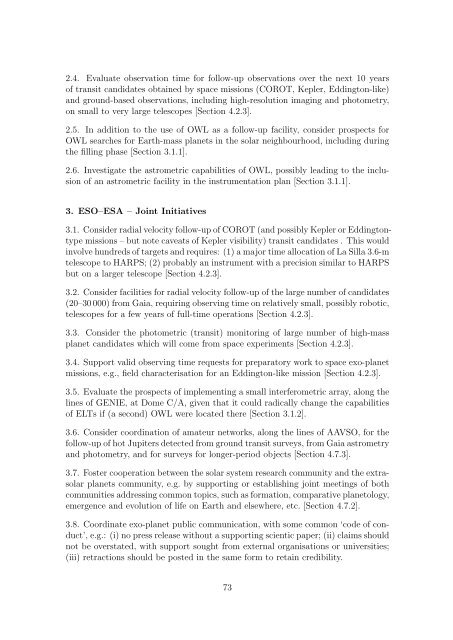Report - School of Physics
Report - School of Physics
Report - School of Physics
You also want an ePaper? Increase the reach of your titles
YUMPU automatically turns print PDFs into web optimized ePapers that Google loves.
2.4. Evaluate observation time for follow-up observations over the next 10 years<br />
<strong>of</strong> transit candidates obtained by space missions (COROT, Kepler, Eddington-like)<br />
and ground-based observations, including high-resolution imaging and photometry,<br />
on small to very large telescopes [Section 4.2.3].<br />
2.5. In addition to the use <strong>of</strong> OWL as a follow-up facility, consider prospects for<br />
OWL searches for Earth-mass planets in the solar neighbourhood, including during<br />
the filling phase [Section 3.1.1].<br />
2.6. Investigate the astrometric capabilities <strong>of</strong> OWL, possibly leading to the inclusion<br />
<strong>of</strong> an astrometric facility in the instrumentation plan [Section 3.1.1].<br />
3. ESO–ESA – Joint Initiatives<br />
3.1. Consider radial velocity follow-up <strong>of</strong> COROT (and possibly Kepler or Eddingtontype<br />
missions – but note caveats <strong>of</strong> Kepler visibility) transit candidates . This would<br />
involve hundreds <strong>of</strong> targets and requires: (1) a major time allocation <strong>of</strong> La Silla 3.6-m<br />
telescope to HARPS; (2) probably an instrument with a precision similar to HARPS<br />
but on a larger telescope [Section 4.2.3].<br />
3.2. Consider facilities for radial velocity follow-up <strong>of</strong> the large number <strong>of</strong> candidates<br />
(20–30 000) from Gaia, requiring observing time on relatively small, possibly robotic,<br />
telescopes for a few years <strong>of</strong> full-time operations [Section 4.2.3].<br />
3.3. Consider the photometric (transit) monitoring <strong>of</strong> large number <strong>of</strong> high-mass<br />
planet candidates which will come from space experiments [Section 4.2.3].<br />
3.4. Support valid observing time requests for preparatory work to space exo-planet<br />
missions, e.g., field characterisation for an Eddington-like mission [Section 4.2.3].<br />
3.5. Evaluate the prospects <strong>of</strong> implementing a small interferometric array, along the<br />
lines <strong>of</strong> GENIE, at Dome C/A, given that it could radically change the capabilities<br />
<strong>of</strong> ELTs if (a second) OWL were located there [Section 3.1.2].<br />
3.6. Consider coordination <strong>of</strong> amateur networks, along the lines <strong>of</strong> AAVSO, for the<br />
follow-up <strong>of</strong> hot Jupiters detected from ground transit surveys, from Gaia astrometry<br />
and photometry, and for surveys for longer-period objects [Section 4.7.3].<br />
3.7. Foster cooperation between the solar system research community and the extrasolar<br />
planets community, e.g. by supporting or establishing joint meetings <strong>of</strong> both<br />
communities addressing common topics, such as formation, comparative planetology,<br />
emergence and evolution <strong>of</strong> life on Earth and elsewhere, etc. [Section 4.7.2].<br />
3.8. Coordinate exo-planet public communication, with some common ‘code <strong>of</strong> conduct’,<br />
e.g.: (i) no press release without a supporting scientic paper; (ii) claims should<br />
not be overstated, with support sought from external organisations or universities;<br />
(iii) retractions should be posted in the same form to retain credibility.<br />
73
















